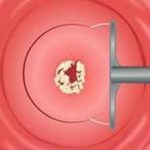The use of laser technologies in medicine has made it possible to radically revise certain variants of operations and the techniques of treatment used. In gynecological practice, they relatively recently became popular, especially among minimally invasive operations. What are the advantages of a laser in gynecology, from what problems will help get rid of?
Twa laser application in gynecology
Laser radiation has many advantages over an electric shock or a scalpel. That is why these technologies are actively introduced into all fields of medicine.
The main advantages of using a laser in gynecology are as follows:- Less painfulness of the whole procedure compared to classical performance. This is due to the fact that the laser instantly coagulates the nerve endings, they do not have time to give a "signal" in the dorsal and brain.
- Small blood loss. The laser, acting on the tissues, simultaneously cauterizes all the vessels, so the volume of the lost blood is much smaller.
- Radiation has a harmful effect on all pathogens in the treated area. Therefore, wounds after this treatment heal better and faster.
- Reduces the execution time of the operation. This makes it possible to spend some on an outpatient basis.
- The terms of rehabilitation are decreasing.
- The number of complications in the postoperative period decreases.
The only drawback of laser treatment is its high price. This is due to the fact that it requires a lot of expensive equipment and training of doctors.
 We recommend reading the article about cauterization of laser erosion. From it you will learn about when to cure erosion, ways of cauterizing, pluses and minuses of each.
We recommend reading the article about cauterization of laser erosion. From it you will learn about when to cure erosion, ways of cauterizing, pluses and minuses of each.
And here it is more in detail about methods of treatment of a dysplasia.
Types of lasers and their features
There are a lot of lasers. But in the gynecological practice, two main ones for surgical intervention and one for therapeutic intervention are found.
Carbon dioxide( CO2) laser
This is one of the first species, therefore it has the maximum damaging effect on surrounding tissues. Because of this, it is used less often than, for example, erbium. At the same time, the energy of the emitted light is absorbed by water from the cells of the body, which leads to their evaporation. In parallel, smoke is released, which can contain microbes and viruses, if they were not exposed to a laser.
Erbium laser
More modern and accurate. It practically does not damage the surrounding tissues. The action of an erbium laser is associated with very short pulses. At the same time, water in the cells absorbs energy and begins to evaporate. But at this moment the effect ends, and it again forms a liquid fraction. Such vibrations in the cells cause their destruction.

Erbium laser is the most optimal and safe for use in gynecological practice for surgical interventions.
Photon Laser( Fotona)
In gynecology, a special erbium laser is widely used for operations, including plastic ones. They are performed on the apparatus Fotona, so the technology received the same name.
The essence of the method is the treatment of tissues by the laser( the anterior wall, the vestibule of the vagina, the circular processing of the entire mucosa, etc.).As a result, more collagen fibers begin to be produced in them, and they become more elastic. The vagina acquires an updated structure, somewhat tapers, the muscles of the pelvic floor are toned down. All this improves the quality of a woman's sexual life and eliminates many problems in different age periods.
Therapeutic laser
This type of laser use implies the effect of radiation directly on the blood flow through a special conductor placed in a venous vessel. It has an anesthetic, immunostimulating, anti-inflammatory effect, metabolism, self-regulation is accelerating, and many other positive effects on the body. It belongs to the category of physiotherapy.
Look at the video about the use of a CO2 laser in gynecology:
What problems in gynecology will the
laser relieve? Each kind of laser is designed for a certain kind of impact. Erbium and carbon dioxide are used in the following cases:
- For diseases of the vulva and vagina: leukoplakia, kraurose, papillomas, condylomas, bistolin gland cyst, endometriosis foci. Also performed plastic surgery to remove the septum and scars.
- In various pathologies associated with changes in the cervix: ectopia, erosion, leukoplakia, dysplasia, retention cysts, endometriosis, papillomas and condylomas. Endometrial Diseases. This leads to cauterization( ablation) of the endometrium, excision of partitions, synechia, removal of polyps of different nature.
The Photon laser is used to a greater extent for performing plastic operations. The need for them can arise in the following cases:
- postpartum recovery of the vaginal tone and volume;
- laser rejuvenation of the vagina;
- treatment of some manifestations of frigidity by stimulating the "G" point and enhancing the natural sensations during sexual intercourse;
- correction of the initial stages of vaginal and uterine wall descent;
- elimination of stress urinary incontinence;
- treatment of atrophic colpitis in women in menopause is a reliable alternative to hormonal correction methods.

In gynecology, laser therapy is used in the following cases:
- for chronic inflammatory processes in the small pelvis( uterus, appendages, etc.);
- in women with recurrent HSV 1 and 2 types, especially in the period of preparation for pregnancy, and after 32 weeks before the birth;
- in chronic pyelonephritis for the prevention of exacerbations during gestation;
- with endometriosis of varying severity;
- in order to reduce infectious complications on the eve of surgical interventions.
Laser assistance for infertility
Depending on the cause of infertility, different types of lasers are used to help a woman and a man in conception.
Erbium and carbon dioxide are used when it is necessary to remove tissues or some new growths. For example, a septum in the uterus or vagina, endometriotic foci, polyps, diseases of the uterine cavity, etc. Laser treatment can be used along with other - endoscopic surgery, drug treatment, etc.
Also used when the cause of the impossibility of pregnancy or bearing is covered in a chronic infection. To this end, the girl is taking courses consisting of 10 to 14 procedures, several times depending on the pathology.
Also this method can improve the quality of spermogram in men: increase mobility, the number of normal forms, etc. To this end, percutaneous or intravenous radiation in the area of the sacrum, perineum, testicles, and, if necessary, rectal stimulation of the prostate, bladder, etc.
Preparation for laser treatment
Preparation for laser treatment depends on the technique and type of pathology. In most cases, the following is required:
- General blood test, urine, biochemical study.
- If the operation is extensive - the definition of the group and Rh factor, HIV and hepatitis markers.
- In cases where interference on the external or internal genitalia is a smear from the vagina, cervix, if necessary, a biopsy of the endometrium or other areas.
- Colposcopy is performed if the tissues of the cervix or vagina are removed.

Laser treatment of gynecological problems
It is impossible to say unequivocally how and how many stages will be treated. Consistency and technique largely depend on what the doctor intends to do - cauterize pathological areas, remove tissues, etc.
Treatment with erbium and carbon dioxide lasers usually involves excision of a site - cervix, condyloma, papilloma, septum, etc. In some cases, the procedure can be performed under local anesthesia, in others, an intravenous, deeper for volumetric operations is needed.
Photon laser treatment is carried out as follows. In the vagina is placed a special installation, with the help of which the tissue is processed according to the specified parameters. Anesthesia is not necessary, but the procedure takes an average of 15 minutes. But you need several sessions.
Recovery after laser treatment
Recovery after laser treatment is much shorter than from similar techniques with other types of energy used. But the duration and rehabilitation depends on how much tissue was removed, whether there are concomitant diseases.
For example, the healing of laser removal of cervical erosion requires 2 to 3 weeks. And after excision of genital warts and papillomas, 7 to 10 days are necessary. Using a laser Photon makes it possible to return to normal life after 3 to 4 hours, and intimate relationships can continue in a week.
Physiotherapy with laser in gynecology
Laser therapy is an effective and widespread method of strengthening the defenses of the body in the fight against various diseases. It is carried out in two ways. They are as follows:
- VLOK - intravenous laser irradiation of blood. The woman is lying on the couch. A vein puncture is performed, usually in the ulnar fossa, and a catheter is inserted. Further, a special conductor is connected through which laser radiation is delivered. As a result, the blood has a therapeutic effect. The session lasts about 20 minutes, the course needs 5-10 procedures.
- Percutaneous laser irradiation of blood. The woman is lying on the couch, but in this case, the puncture of the vessel is not performed, and the laser beam stream is fed to those parts of the body where the arteries and veins fit as close to the skin as possible. Usually it is a wrist, a sino-carotid zone and others.
And here is more detailed about the consequences of cauterization of cervical erosion.
Laser radiation has several advantages over other technologies and methods of treatment. Modern developments make it even more suitable for dealing with various gynecological diseases, for example, the photon technology. In any case, the indications and limitations for laser treatment are established only by a specialist of this profile.


 We recommend reading the article on removing moles by laser. From it you will learn about the methods of removal of moles, the use of laser and other techniques, the possibility of performing surgery with menstruation.
We recommend reading the article on removing moles by laser. From it you will learn about the methods of removal of moles, the use of laser and other techniques, the possibility of performing surgery with menstruation.